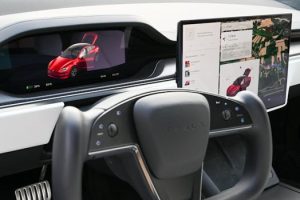Augmented Reality Enhances Next-Gen Car Displays
In the world of automotive technology, the use of augmented reality (AR) is rapidly on the rise. This rapidly evolving technology has the ability to transform the way we interact with our vehicles. From improving safety to enhancing the overall driving experience, AR has become an integral part of next-generation car designs. In this article, we’ll explore the various ways in which augmented reality is enhancing the next-gen car displays.
The Basics of Augmented Reality
Before we delve into how AR is improving car displays, let’s first understand the basics of this technology. Augmented reality is a computer-generated technology that overlays real-world visuals with virtual elements, creating an interactive experience. This technology has been used in various sectors, such as gaming and healthcare, but is now also making its way into the automotive industry.
Safety on the Roads
The most crucial aspect of any vehicle is safety, and AR plays a fundamental role in improving it. AR technology can overlay real-time information such as speed, navigation, and hazards onto the car’s windshield or dashboard, allowing drivers to keep their eyes on the road while still having access to important information.
Heads-Up Displays (HUDs)
One of the ways AR is enhancing the next-gen car displays is through the use of heads-up displays (HUDs). These displays project critical information such as speed, navigation, and driver assistance alerts onto the windshield, making it easier for the driver to keep their eyes on the road. This feature improves safety by reducing the need for drivers to look away from the road to check their dashboard or navigation system.
Digital Side Mirrors
Another way AR is improving safety is through the use of digital side mirrors. Traditional mirrors have limited visibility and are prone to blind spots, but digital side mirrors use AR technology to display a wide-angle image of the vehicle’s surroundings on a high-definition screen located on the pillars of the car. This allows for better visibility and significantly reduces accidents caused by blind spots.
Enhancing the Driving Experience
Aside from safety, AR is also improving the overall driving experience by making it more engaging and interactive. With the use of AR technology, drivers can personalize their dashboard and display real-time information based on their preferences. For example, drivers can customize their display to show traffic updates, favorite songs, or even virtual landscapes that change according to the vehicle’s location. This not only adds a level of personalization but also makes driving a more enjoyable experience.
Navigation and Wayfinding
One of the biggest challenges while driving is navigating to a new destination without getting lost. With AR technology, drivers can use a navigation system that overlays virtual arrows and directions onto the road, making it easier to follow without taking their eyes off the road. This feature also minimizes distractions, as drivers no longer have to glance at their phone or navigation device for directions.
Vehicle Diagnostics
Another benefit of augmented reality in next-gen car displays is the ability to provide real-time vehicle diagnostics. With AR, drivers can access information on fuel levels, tire pressure, and engine performance without leaving their seats. This feature is especially useful for drivers on long trips, as they can continuously monitor the health of their vehicle and address any potential issues before they escalate.
In Conclusion
It’s clear that augmented reality is revolutionizing the way we interact with our vehicles. By improving safety, providing personalized displays, and enhancing the overall driving experience, AR is quickly becoming a crucial part of next-generation car displays. With the continuous advancement of technology, we can expect to see even more innovative ways in which AR will improve our driving experience in the future.











